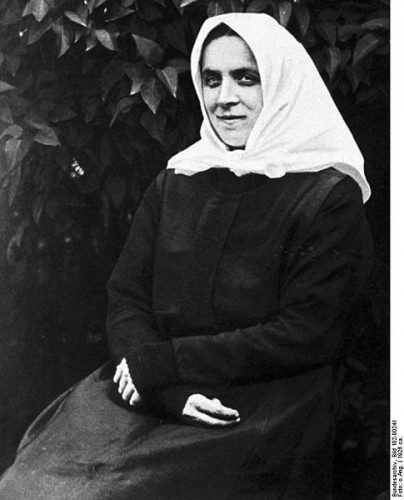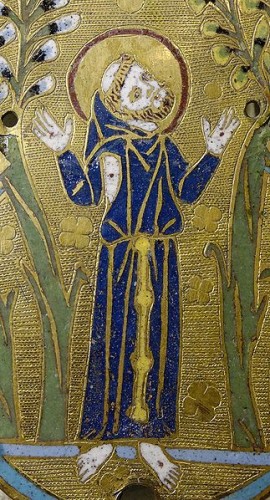The Mystery of the Five Wounds
The first case of stigmata—the appearance of marks or actual wounds like those Christ received during the Crucifixion—was recorded in 1224
/https://tf-cmsv2-smithsonianmag-media.s3.amazonaws.com/filer/Padre-Pio-web.jpg)
On September 14, 1224, a Saturday, Francis of Assisi—noted ascetic and holy man, future saint—was preparing to enter the second month of a retreat with a few close companions on Monte La Verna, overlooking the River Arno in Tuscany. Francis had spent the previous few weeks in prolonged contemplation of the suffering Jesus Christ on the cross, and he may well have been weak from protracted fasting. As he knelt to pray in the first light of dawn (notes the Fioretti—the ‘Little flowers of St Francis of Assisi,’ a collection of legends and stories about the saint),
he began to contemplate the Passion of Christ… and his fervor grew so strong within him that he became wholly transformed into Jesus through love and compassion…. While he was thus inflamed, he saw a seraph with six shining, fiery wings descend from heaven. This seraph drew near to St Francis in swift flight, so that he could see him clearly and recognize that he had the form of a man crucified… After a long period of secret converse, this mysterious vision faded, leaving… in his body a wonderful image and imprint of the Passion of Christ. For in the hands and feet of Saint Francis forthwith began to appear the marks of the nails in the same manner as he had seen them in the body of Jesus crucified.
In all, Francis found that he bore five marks: two on his palms and two on his feet, where the nails that fixed Christ to the cross were traditionally believed to have been hammered home, and the fifth on his side, where the Bible says Jesus had received a spear thrust from a Roman centurion.
Thus was the first case of stigmata—the appearance of marks or actual wounds paralleling those Christ received during Crucifixion—described. Later stigmatics (and there have been several hundred of them) have exhibited similar marks, though some bear only one or two wounds, while others also display scratches on their foreheads, where Christ would have been injured by his crown of thorns. Through the centuries, stigmata has become one of the best-documented, and most controversial, of mystical phenomena. The extensive record makes it possible to compare cases that occurred centuries apart.
Why, though, to begin with, did stigmata materialize in 13th-century Italy? Part of the answer seems to lie in the theological trends of the time. The Catholic Church of St. Francis’s day had begun to place much greater stress on the humanity of Christ, and would soon introduce a new feast day, Corpus Christi, into the calendar to encourage contemplation of his physical sufferings. Religious painters responded by depicting the crucifixion explicitly for the first time, portraying a Jesus who was plainly in agony from wounds that dripped blood. Indeed, the contemporary obsession with the marks of crucifixion may best be demonstrated by an incident that occurred in Oxford, England, two years before St. Francis’s vision: a young man was brought before the Archbishop of Canterbury and charged with the heresy of declaring he was the son of God. In court it was discovered that his body bore the five wounds; but the record includes no suggestion that these were spontaneously generated, and it seems he may actually have allowed himself to be crucified, either because he genuinely believed he was Christ, or because he wanted others to believe he was.

Therese Neumann, the controversial German stigmatic, claimed to have lived for years on nothing more than Communion wafers and wine. Photo: Bundesarchiv via Wikicommons
It is unlikely news of this strange case ever reached Francis in Assisi. On the other hand, it is indisputable that the saint’s fame ensured that the story of his stigmatization soon became known throughout Europe, and before long other cases of stigmata began to appear. At least ten more were recorded in the 13th century, and a recent estimate by the former BBC religious correspondent Ted Harrison sets the total number reported since 1224 at just over 400. These include such noteworthy cases as that of Johann Jetzer, a Swiss farmer who displayed the stigmata in 1507, and Therese Neumann, a controversial German stigmatic on whom the marks appeared on Fridays from 1926 until her death in 1962 (though never convincingly in the presence of scientific observers). Padre Pio, a Capuchin monk who is probably the best known of all stigmatics, is also supposed to have experienced a number of other strange phenomena and to have effected numerous miraculous healings. (Stigmatics are often associated with other miraculous events.) Pio was canonized by Pope John Paul II in 2002.
Until the twentieth century, reports of stigmata were confined to Catholic Europe, but the most recent count of contemporary cases, made about a decade ago, included about 25 cases scattered around the world, including one in Korea and one in Japan. This in itself is a remarkable development, but there has also been a dramatic change in the ratio of male to female stigmatics. Overall, the vast majority have always been women: 353, compared to just 54 men, a ratio of almost seven to one. But according to Harrison’s analysis, that ratio has changed dramatically in the last half-century. Among the 44 cases reported since 1946, it is 2.4:1, and among living stigmatics it is a mere 1.5:1. Harrison suggests that this may be explained “by the changes in the balance of authority between men and women, both in the church and society,” and that in previous centuries women may have manifested stigmata to draw attention to themselves in a society dominated by men and in a church that excluded them from the priesthood. Citing stigmatics who effected local religious revivals or became the leaders of messianic sects, Harrison notes “the role stigmata plays in granting to individuals and congregations a direct spiritual authority.”
The record shows other patterns as well. Before Padre Pio, no priest had received the stigmata; since then, a number have. Cases appear in clusters: a single case occurred in the Iberian peninsula between the 13th and 15th centuries, but 54 were recorded between 1600 and 1799—and there have been only seven since. And the location of the wounds themselves has begun to change as medical knowledge has advanced. Traditionally, two of the five wounds have appeared on the palms, where countless icons have shown the nails that were supposed to have been hammered into Christ’s hands during crucifixion. It has since been determined that nails positioned in this way cannot support the weight of a body, and that the Romans crucified their victims by driving a nail into the arm just above the wrist. In at least two recent cases, the skeptic Joe Nickell notes, the stigmatic has bled from wounds there.
What all this suggests—even to many Catholic writers on the subject—is, first, that this phenomenon is culturally based. There seem to be no parallels in any of the major non-Christian religions, and, with the exception of the odd 20th-century Anglican or Baptist stigmatic, sufferers are invariably members of the Roman Catholic church. Evidence for the reality of stigmata, moreover, is sketchy at best; Father Herbert Thurston, the great Jesuit authority on the physical phenomena of mysticism, contended that there had been no completely believable case since that of St. Francis himself. Today, the Catholic church itself takes a cautious view of the phenomenon, accepting that miracles can indeed occur while declining to formally acknowledge even St. Francis’s stigmata as miraculous.
How, then to explain this phenomenon? Fraud certainly figures in some cases. Magdalena de la Cruz, the famous Spanish stigmatic of the 16th century whose frequent self-mortification and spectacular wounds made her a favorite at court, eventually confessed to having inflicted her own injuries. Similarly, Johann Jetzer, who claimed to have experienced not only recurrent poltergeist phenomena but also a series of religious visions, confessed in 1507 that his stigmata were fake. Four friars from his monastery were subsequently burned at the stake, and Jetzer himself escaped death only after his mother smuggled him a set of women’s clothes, in which he bluffed his way out of his death cell.
Aside from cases of outright fraud, which may well form the majority of all cases, the appearance of stigmata appears to be an essentially psychological condition whose manifestations are determined by the cultural expectations of the stigmatics themselves. A large number of sufferers seem to have displayed abundant evidence of low self-esteem, health problems, or a tendency toward self-mutilation—a potent mix when combined with exposure to the pervasive iconography of centuries of Christian tradition. It has been shown beyond a reasonable doubt that many have inflicted the five wounds on themselves, sometimes unconsciously, perhaps while in an altered state of consciousness brought on by extensive fasting or intensive prayer.
An example: Teresa Musco, a stigmatic from Naples, endured a lifetime of bad health and a total of more than 100 operations in the years leading to the early death she had predicted for herself. (She died in 1976 at the age of 33—the same age as Christ.) While she lived, Teresa habitually described herself as “a dungheap,” and her diary frequently contained the exhortation, “Lord, use me as your cleaning rag!” A contemporary, Therese Neumann, suffered blindness and convulsions as a result of head injuries, and claimed that she had lived for more than three decades on nothing more than the bread and wine she received daily at Communion. Thurston discussed her case under the heading “Hysteria and dual personality.” The modern English stigmatic Jane Hunt began to display the signs of the Passion in 1985 after suffering a series of miscarriages, and ceased to do so after she had a hysterectomy in 1987.
In at least some of these cases, investigators such as Harrison have argued, substantial evidence indicates the original wounds can recur spontaneously and apparently psychosomatically, generally on significant dates. During the 1990s, for example, an Italian woman named Domenica Lo Bianco exhibited the stigmata on Good Friday. Her fame spread, and Harrison notes that an Italian psychotherapist, Dr Marco Margnelli, has reported videoing Lo Bianco in a laboratory as she relived one incident of stigmata in a “trance state.” According to Margnelli, marks appeared spontaneously on his subject’s arm as she was taped and outright fraud could be ruled out as an explanation.
If that’s true, then Harrison may be correct in suggesting some cases of stigmata may be attributable to psychosomatic causes—in other words, to the power of suggestion. The alternative, proposed by skeptics such as Joe Nickell, is that all known cases, including St. Francis’s own, are pious–or less than pious–frauds. “Experimental attempts to duplicate the phenomenon,” Nickell writes, “have been ultimately unsuccessful I feel that hoaxing–the proven explanation in numerous cases–provides the most credible overall suggestion.” He contends that even men such as St. Francis, unwilling to “perpetrate deception for crass motives,” might agree to “a pious hoax—one that would, to Francis’s mind, promote the example of Christ to others.”
Nearly eight centuries on from that day on Monte La Verna, the jury remains out; its final verdict ultimately depends on a fine judgement of human nature. Fraud or more than fraud? Hardened skeptics feel certain that they know the answer, but, for the more religiously inclined, even a close look at the record has not yet entirely deprived this phenomenon of its mystery.
Sources
Ted Harrison. Stigmata: A Medieval Mystery in a Modern Age. New York: Penguin Books, 1999; Joe Nickell. Lo0oking for a Miracle: Weeping Icons, Relics, Stigmata, Visions and Healing Cures. Amhurst : Prometheus Books, 1998; Herbert Thurston. The Physical Phenomena of Mysticism. London: Burnes Oates, 1952; Ian Wilson. The Bleeding Mind: An Investigation into the Mysterious Phenomenon of Stigmata. London: Weidenfeld and Nicolson, 1988
/https://tf-cmsv2-smithsonianmag-media.s3.amazonaws.com/accounts/headshot/mike-dash-240.jpg)

/https://tf-cmsv2-smithsonianmag-media.s3.amazonaws.com/accounts/headshot/mike-dash-240.jpg)